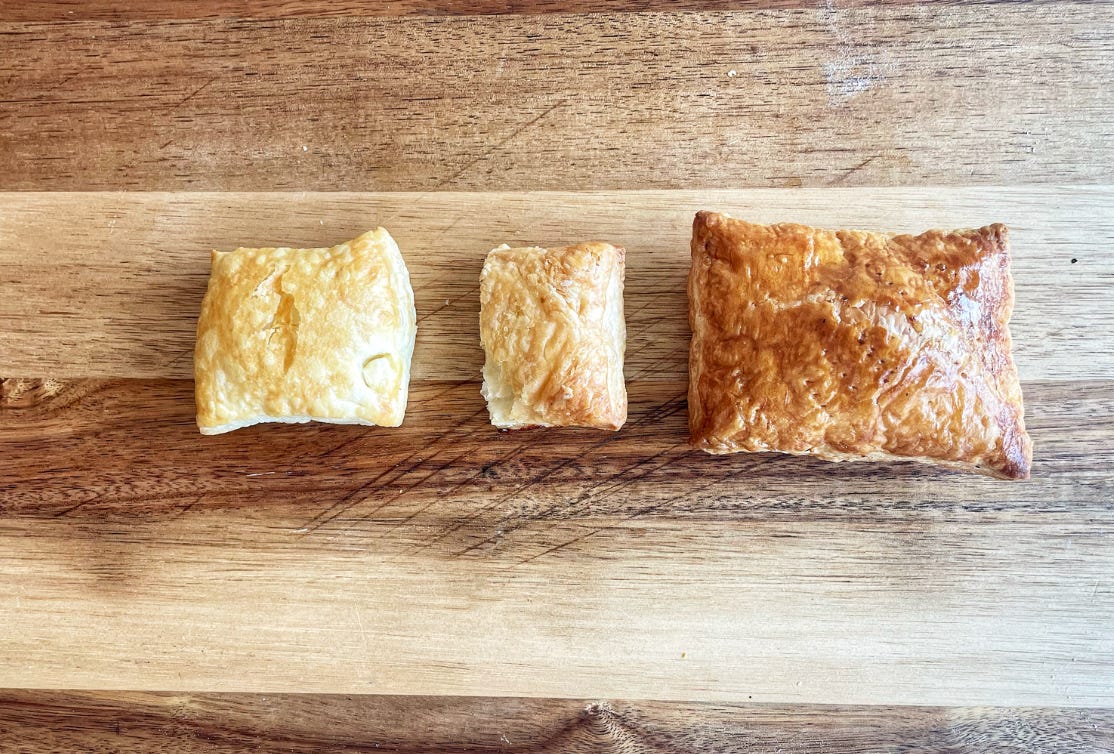Puff Pastry Secrets Every Baker Should Know
The science of lamination, butterfat, and water content that makes or breaks your bake.
Upside-down puff pastries are making a comeback. It’s a fun and creative twist on traditional baking, but getting it right takes a bit of know-how. Let’s dive into the science behind why this method can lead to flaky success—or fall flat.
What Puff Pastry Really Is
Puff pastry is made from just four ingredients—flour, water, salt, and butter—but the method makes it magical. It’s not like bread, where yeast does the lifting. Instead, puff pastry depends entirely on lamination and steam to create those signature, paper-thin layers.
Flour + water = gluten
Flour’s two main proteins (glutenin and gliadin) bond with water, forming gluten. This structure is strong but stretchy, able to trap expanding steam as the pastry bakes.Butter layers = lift
During lamination, thin sheets of butter are layered between sheets of dough. As the butter melts, its water evaporates into steam, pushing up the dough layers and creating that signature puff.
Think of puff pastry as steam engineering in your oven.
Lamination: The Key to Flakiness
Lamination is what makes puff pastry… puff. The folding and rolling process creates dozens (sometimes hundreds) of alternating layers of dough and butter.
When baked:
The butter melts, releasing water.
That water evaporates into steam, lifting the dough.
The gluten structure sets, locking everything in place.
No lamination, no puff.
Tips for Puff Pastry Success
Here’s where home bakers often go wrong—and how to fix it:
✨ Hydration control
Too much water = sticky dough that bakes up chewy instead of flaky.
Pro tip: swap some water with vodka. Gluten doesn’t form in alcohol, so this limits toughness and makes the dough easier to handle.
✨ Butter choice
Not all butter is created equal. European-style butters (82–84% fat) have less water and more fat, giving stronger layers and richer flavor. Regular “sweet cream” butter has too much water, which can collapse layers.
✨ Temperature matters
Cold is everything. If the butter melts into the dough before baking, the layers are lost. Chill your dough often, work quickly, and bake straight from the fridge.
The Upside-Down Pastry Trend
Here’s the fun twist: instead of filling inside or on top, you layer fruit, veggies, or cheese at the bottom of the pan, cover with puff pastry, bake, then flip.
But here’s the science catch: water content.
High-water ingredients = soggy fail. Fresh tomatoes, zucchini, or watery fruit release steam that collapses the layers, leaving you with chewy dough instead of crisp pastry.
Low-water ingredients = flaky win. Roasted or sun-dried tomatoes, caramelized onions, apples, or stone fruit with reduced moisture are all better options.
It’s not that you can’t use fresh produce—it just needs prep (like roasting, salting, or draining) to reduce water before it hits the oven.
👩🔬 Want More?
Want to learn more? Have a questions? Reply and let me know—I always love talking about the science behind baking.
Stay Sweet,
Sarah @HalfBatchBaking




